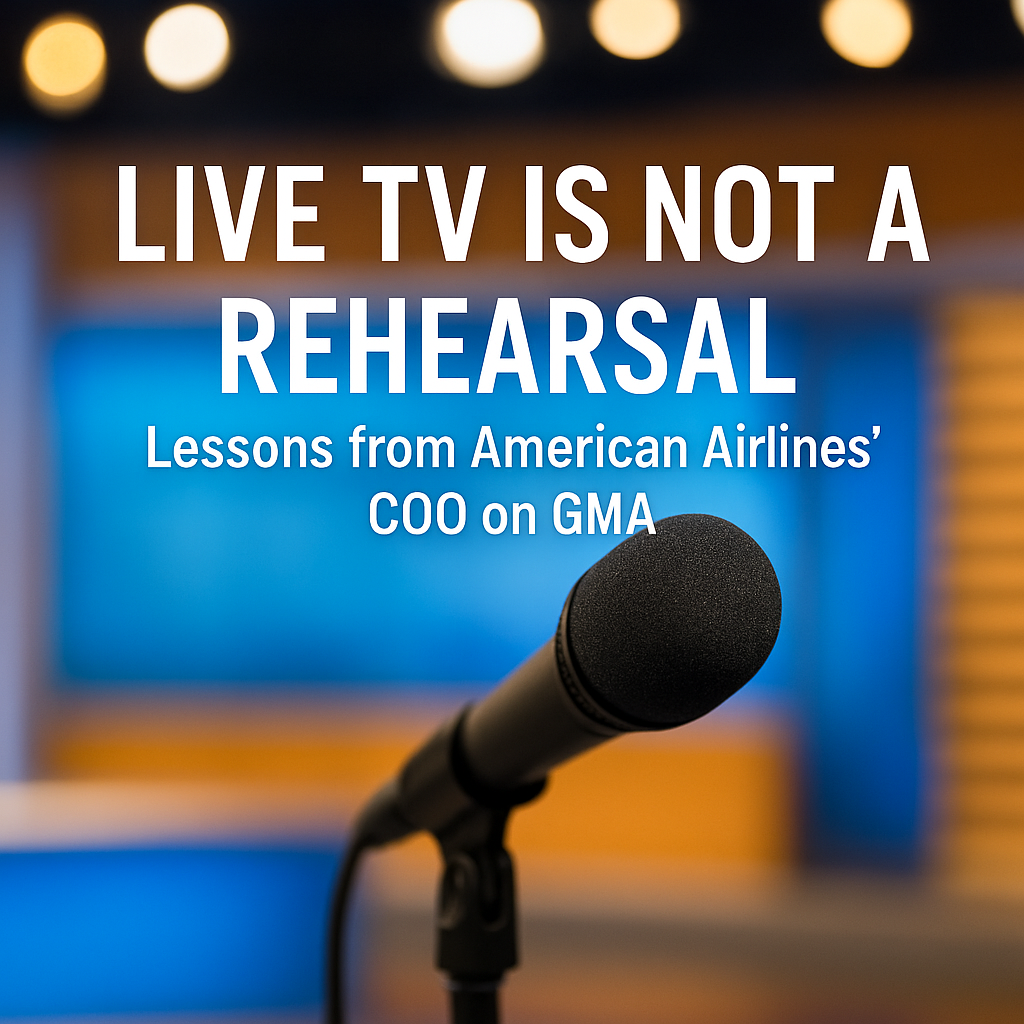When American Airlines’ Chief Operating Officer appeared on Good Morning America last week to discuss the government shutdown and Department of Transportation flight reductions, the stakes were high. With millions of travelers affected and national attention focused on air traffic control shortages and delays at TSA checkpoints, this was the airline’s chance to project calm, control, and confidence.
Since then, the federal shutdown has ended and the Department of Transportation has lifted many of the flight-reduction directives, with airlines now working to return operations to normal. But the communications lesson remains the same: every spokesperson must be ready when the spotlight turns on.
Instead, the interview came off uneasy. The COO’s answers were filled with “umms” and “ahs.” He shifted his weight, swayed while speaking, and seemed to search for his words. It wasn’t a communications disaster, but it was distracting—and for a company of that size, distraction equals dilution. The message never fully landed.
For communicators, this was a masterclass in why preparation matters. Live television is not a rehearsal. The camera doesn’t forgive hesitation, and the audience doesn’t separate nervousness from uncertainty.
The Spokesperson’s Role Isn’t Optional
Whether you’re leading a multinational corporation, a public agency, or a small municipal department, the moment you step in front of a camera, you are the message.
Your tone, posture, and pacing communicate as much as your words. A steady voice builds credibility; a scattered one creates doubt.
A skilled public information officer—or communications lead—exists to prevent exactly what we saw on GMA. The PIO’s job isn’t just to write talking points; it’s to coach people to deliver them effectively, to anticipate tough questions, and to ensure every representative of the organization looks and sounds prepared.
Even senior executives like COOs and CEOs need that support. In fact, the higher the title, the greater the stakes.
Anticipation is Preparation
Preparation begins long before the red light on the camera turns on. Every spokesperson should be ready for the easy questions, the hard ones, and the curveballs.
That’s where the 5×5×5 Method comes in—a simple but powerful framework used in professional media coaching.
Five Easy Questions
These are the ones you know are coming. They should be answered with confidence and clarity.
- “What’s happening with flight reductions?”
- “How will this impact travelers?”
- “What’s the airline doing to respond?”
- “How long will this last?”
- “What do you want passengers to know today?”
These questions test poise and polish. If they sound unsure here, the interview is already on shaky ground.
Five Difficult Questions
These are the ones that test composure and consistency under pressure.
- “Why wasn’t this anticipated?”
- “Will ticket prices rise?”
- “Is the FAA blaming the airlines?”
- “Are safety standards being compromised?”
- “What do you say to passengers who’ve lost confidence?”
The goal is not to avoid these questions, but to handle them with honesty and control—acknowledge the issue, explain the facts, and steer back to solutions.
Five Wild Questions
These are the “what if” or emotionally charged questions designed to catch you off guard.
- “Is air travel unsafe right now?”
- “Could this trigger mass cancellations?”
- “Is the government to blame?”
- “Would you fly today?”
- “Should travelers be worried?”
In a live interview, these questions can derail an unprepared speaker in seconds. The best communicators practice these, too, so they can pivot back to reassurance and clarity.
Coaching Builds Confidence
Every spokesperson benefits from rehearsal. That means mock interviews, recorded practice sessions, and immediate feedback on tone, posture, and word choice.
The best PIOs act like coaches—not critics—helping spokespeople feel ready and confident while staying authentic to their own voice.
Coaching also means focusing on nonverbal cues. Nervous shifting, fidgeting, or looking away from the camera can undermine even the strongest statement. Calm body language reinforces control. Consistent tone signals confidence. Eye contact builds trust.
The goal isn’t to turn people into robots—it’s to make sure they’re the best, most credible version of themselves when it matters most.
Why This Matters
In communications, perception shapes trust. A shaky delivery from a corporate leader or government official can leave the public feeling uncertain, even when the facts are solid.
When confidence wavers, credibility wavers—and credibility is the currency of every organization, especially in crisis.
That’s why media readiness isn’t just a task before a press conference; it’s an organizational responsibility. Leaders must invest in it, and communicators must insist on it.
The government shutdown has since ended, and the Department of Transportation has eased the restrictions that prompted those reductions. Airlines are now focused on returning to normal operations.
But whether in crisis or recovery, the lesson is constant: leaders must be ready to communicate clearly and confidently when the public is paying attention.
The Takeaway
When you step in front of a camera, you’re not just answering questions—you’re performing trust.
Preparation, rehearsal, and coaching aren’t luxuries; they’re the foundations of effective communication. The American Airlines interview serves as a reminder: live television is never a rehearsal. It’s showtime.
So, whether you’re a CEO, a corrections warden, a fire chief, or a city manager, take the time to prepare.
Because when the world is watching, how you deliver your message matters just as much as what you say.

